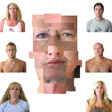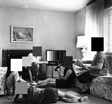2009W
2.03.2009
Arts 102 UCSB
Pixel Project
Family Collage, Amanda Appel
When I started to think about the pixel as the basic unit of an image I started drawing connections between the pixel and DNA. In Photoshop the pixels hold the basic information of the image, and when an image is enlarged a pixel will draw from, and average out, the information from surrounding pixels. This is very similar to the way that DNA from the X and Y chromosome are averaged and determine which phenotype the resulting organism will have. Therefore, I attempted to create an image by using photographs of my family to create an entirely new human being/image that draws information from all of the pre-existing people/images.
BW Family with TV, Paulo Fong
This image relates to the significance of the pixel in modern day life--relating to everything visual related, from pictures to television to videogames to computer screens, the pixel is the backbone of our technological evolution. The average viewer doesn't think about distinct pixels when using a display device, primarily because the pixels work together to display an image. This image I manipulated is an homage, if you will, to the pixel and its effect throughout our lives.
Red Guards, Sean Finch
Illustrates how much technology has changed over the years, by showing how a photograph might have looked 20 years ago on a computer
40000 Shoes, Kim Bui
i've decided to do away with pixellating filters and effects and instead run with the concept of the pixel as the smallest unit of information in an image.
i first grabbed 100 images of varying shoes from zappos.com and assembled them in photoshop into a grid of 10 x 10. i chose shoes because they are the smallest unit of our everyday attire, a symbol of our individuality although located at the bottom of our figures. Next, i shrunk the image of 100 shoes down to a width of 100 pixels and reassembled these tiny images onto another grid of 20 x 20 - thus creating a span of 40,000 shoes. with this many shoes, each sense of individuality becomes lost. the shoes become smaller pieces of information, yet still hold an important place in the overall textile pattern. (Reference picture: 100 shoes)
Flowers, Melissa Hebeler
The picture is made up of different photos I took that are related to the colored pixels of the original photograph.
Halftone Baby, Sandy Brown
This image was originally a picture of a child looking up into the camera. I decided to separate the child from the background and created two layers. The background's picture became blurred after resizing it two times. Then by applying the pixel filter, the pixels were enlarged and changed color. The background is just sand that became enlarged by the pixel filter. The goal was to have a play of textures that work together to seem as if it were one image or layer.
Image Mixer, Naree Park
Pixels are randomly selected on an image/object ready for print, scan, or projection and is alternated, zoomed to a random size, change in opacity, noise. random effects occur.
Concept Map, Cameron Boulton
Using data aggregated from a Wi-Fi device, a map can be created of all detectable Service Set Identifiers (SSIDs) and then graphed in real-time on a pixel graph. In the context of art, such an installation could be built that allows viewers to join a particular Wi-Fi access point with their Wi-Fi enabled device and then move about the room with other viewers and watch as their respective signal strength ratio changes in real time. With enough people participating with the installation and aesthetically interesting fluctuation would propagate throughout the data/graph display.
Pixel, Christopher Faredan
Pixel is created from three different pixelate tools; crystalize, pointilize, and mosaic. I then took random parts of each image and melded them together. I like some clarity in the piece, therefore i left the samurai's dace untouched by the pexelate tools. It creates and imaage that seems as if the figure is being consumed by the pixelation.
Bright Pixels, MC
The image I chose to use for this project was a fairly simple portrait because of the universally recognizable features of a face. I knew that I wanted to obscure the image to the point of questionable recognition, so I chose something that wouldn't be too difficult to figure out over time.
Dancer, Jana Sepulveda
I wasn't sure what I wanted to do so I decided to push the limits of the recognizable. I tried it with three different images and saw how they each turned out. It was also something to do with being a voyeur but not being able to see anything that you would normally.










